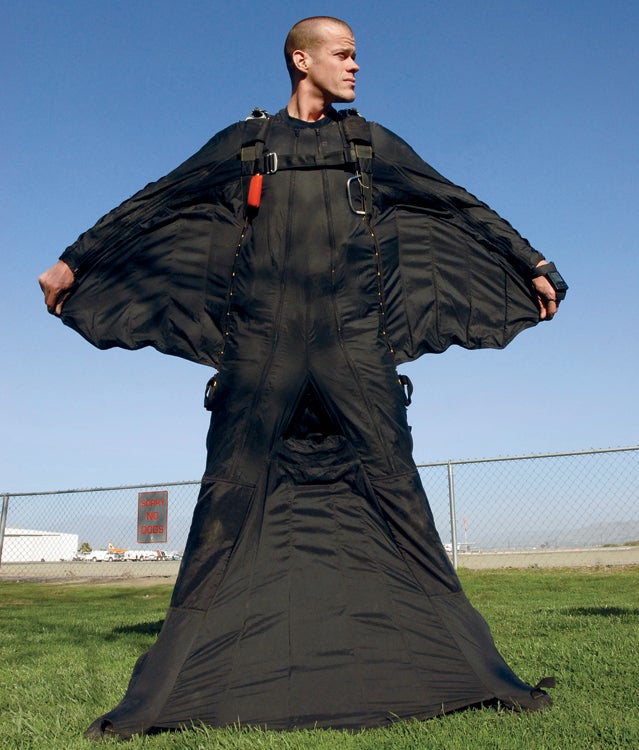��“ARE YOU ON CRACK?” Jeb Corliss, normally fidgety and intense, is getting really animated now. It's late November, and we've been talking for 45 minutes, mostly about his trial here in New York City. The 32-year-old Californian is facing a misdemeanor charge of reckless endangerment for attempting to BASE-jump off the Empire State Building's observation deck in 2006 after sneaking his parachute in by hiding it under a fat suit. Corliss finds his accusers' arguments, which have included testimony from a physics professor and a wind expert, “surreal” and “insulting.” As he sees it, they must be on drugs.
��
Bobbing his head and waving his hands like a magician as he pontificates “I'm one little dude going against an empire!” Corliss seems a bit high himself. His stimulant of late, besides adrenaline, is media attention, which he's been mainlining ever since The New York Times ran a front-page story in December 2007, and this magazine rendered an illustration in February 2008, on his grand dream to jump several thousand feet out of a helicopter and land safely on the ground without pulling the rip cord on his parachute. The paper said that his quest “to fly,” shared by a small number of elite BASE jumpers around the world, “evoked the spirit of nations' pursuit of Everest and the North and South Poles.”
The story was picked up by outlets around the world, and Corliss sat for interviews with the likes of The Early Show, Today, and The Colbert Report. Just before the trial got started in November, ESPN ran a 12-minute special on the project, called “Wing and a Prayer.” Legal calamity aside, it's all playing out rather well for Corliss, who desperately needs to stay in the spotlight if he's going to raise enough cash to pull off his big jump. He claims he's got the technical side sorted out the key components are a specially designed wingsuit and a slippery landing strip designed by NASA contractors that angles up into the sky. But he needs a minimum of $3 million to put it all together, which is why he's target=ed the Las Vegas Strip as the ideal venue. “It'll be equivalent to summiting Everest in front of 500,000 people,” he tells me, repeating a spiel he's honed over the past year. “It's the biggest deal in advertising.” Whether or not Corliss ever lands a sponsor he claims he's close his ability to generate so much hype points to a potentially bright future as America's next stunt king.
Corliss admits he was suicidal as a teenager but insists his big jump is safe and says his goal is to make it a repeatable event in a variety of venues. Still, he calls his effort the Icarus Project. As a depressed high-schooler, Corliss moved all over the world with his art-dealer parents, before he discovered skydiving at age 18 and quickly moved on to BASE jumping. On a trip to Italy in the late nineties, he saw his first wingsuit, a nylon getup that allows a jumper to glide like a flying squirrel. He was an instant convert.
Early on, Corliss learned that he could sell footage from his jumps to television producers, one of whom picked him in 2005 to host the now defunct Discovery Channel series Stunt Junkies. Corliss, who wasn't permitted to BASE-jump for the show, says he hated the gig. After his 2006 arrest in New York, his problem was solved. He was fired.
Corliss got back in front of the camera for Journey to the Center, a documentary released on DVD this winter that chronicles his trip with two other BASE jumpers to drop into a massive cave in southwest China. The movie, for which he was also an executive producer, delivers a compelling adventure travelogue, along with predictably gnarly action, and won a prize at last year's Banff Mountain Film Festival. It was a victory for Corliss, who says he plans to go into filmmaking when his stunting days are over.
For now, though, he's got to focus on his legal troubles. In December, a jury will return a guilty verdict on the reckless-endangerment charge. He's unlikely to serve any jail time, but he'll still have to defend against a $12 million civil suit brought by the Empire State Building's owners, who claim he injured a security guard and damaged the landmark's reputation. Then again, Corliss is countersuing for $30 million, alleging defamation and loss of income. If by some miracle he wins, the whole episode could be his golden parachute.
“The reality is,” says Corliss, still confident and cocky in November, “my wingsuit landing might be sponsored by the Empire State Building.”
A BRIEF HISTORY OF
Jeb Corliss
The highs, lows, and sudden impacts of America's ace of BASE
1997
After learning to skydive, Corliss makes his first BASE jump. At this ppoint, he's still an angry teen with a death wish. Flying becomes his reason to live.
1998
Makes his first wingsuit jump and soon learn proximity flying, contouring the landscape and getting really close to other fixed objects, like buildings and bridges.
1999
Breakes his back in three places after leaping too close to 364foot Howick Falls, in South Africa, and getting sucked into the water column.
October 2003
Corliss's jumping partner Dwain Weston is killed when a proximity stunt going wrong and he hits Colorado's Royal Gorge Bridge. Corliss, flying just below Weston, lands unhurt.
April 2006
Arrested on the 86th floor of the Empire State Building as he attempts a jump using a chute he's snuck in under a fat suit. Discovery fires him as host of its series Stunt Junkies.
April 2007
Corliss flies his wingsuit beneath the arm of the statue of Jesus Christ overlooking Rio de Janeiro. The stunt shows Corliss how he might line up on a runway for a chuteless landing.
November 2008
Journey to the Center wins Banff's Best Film on Mountain Sports award. The travelogue follows Corliss's journey to BASE jump into a cavern in southwest China.
December 2008
After three weeks, a jury returns a guilty verdict in Corliss's misdemeanor trial for the Empire State Building incident. At press time, sentencing had not yet taken place.


